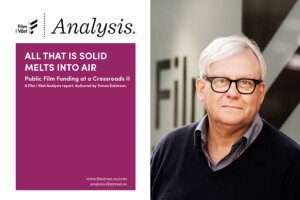During the film festival in Venice Film i Väst Analysis introduces av unique, pan-European study, All that is solid melts into air – Public Film Funding at a Crossroads II. It is presented at a seminar as a part of Venice Production Bridge by Tomas Eskilsson, head of Film i Väst Analysis.
 Public Film and Audiovisual Policies and Funding at a Crossroads is a research project in three parts that explores and discuss the future purpose and relevance of film and audiovisual funding. Last year’s much talked about and debated report Public Film Funding at a Crossroads is now followed up with All that is solid melts into air – Public Film Funding at a Crossroads II.
Public Film and Audiovisual Policies and Funding at a Crossroads is a research project in three parts that explores and discuss the future purpose and relevance of film and audiovisual funding. Last year’s much talked about and debated report Public Film Funding at a Crossroads is now followed up with All that is solid melts into air – Public Film Funding at a Crossroads II.
In the second report, we go head-to-head with the historical, current and future aims of film and audiovisual policy and funding. The ecosystem has been transformed, the sector has undergone a paradigm shift driven by digitalisation and globalisation. The power centers of the traditional financing system have been challenged by new global players as well as by growing and more favorable incentive systems in Europe and the rest of the world.
The majority of Europe’s citizens have access to a wider range of films and dramas than ever before – a range that one can enjoy when you want, how one want and where one want. What does this mean for the future position of cinema/movie theatres in politics and in the sector as such.
Market failures, market shortages, competitiveness and cultural diversity have been core elements in film and audiovisual policies and practices. How should they be understood in a much different context? How should the scope for audiovisual policies be understood, how many formats and expressions should be included in different funding programs and who can be a beneficiary? What should be prioritised? Overproduction or not? How should Europe, and the sector handle the massive amount of cinema films that reaches an ever-smaller audience in cinemas?
Is it reasonable for there to be two completely different directly or indirectly funded public funding systems in Europe that operate with fundamentally different objectives and principles? Is it possible and, if so how to create a common logic?
The report’s recommendations underline the importance of remembering the origins of film and audiovisual policy and putting the citizens/audience in focus. Other core virtues reflected are the importance of coherence, flexibility and the dare to prioritise.
The reports are based on in-depth interviews with over 1,000 key persons in Europe’s film and audiovisual sector along the entire value chain, but also on focus group meetings, workshops and close collaboration and dialogue with territorial experts. The study is pan-European.
In the final report we will reflect the answers and necessary strategies for the future. And reveal our suggestion for a new reformulated European platform for film and audiovisual policy and practice.
About Film i Väst Analysis
Film i Väst Analysis is a unit within Film i Väst. The unit works with external analysis, business analysis and strategic development in the film and audiovisual industry. Film i Väst Analysis produces forecasts and scenarios for future developments primarily in the medium term. Film i Väst Analysis has a special focus on public film funding – the concept of film funding includes all expressions and formats that work with storytelling on a cinematographic basis. Concept of film funding includes all expressions and formats that work with storytelling on a cinematographic basis.
Studies published:
- Public Film Funding at a Crossroads by Tomas Eskilsson
- Streaming Giants and Public Film Funding by Michael Gubbins
- Creative Overload by Wendy Mitchell
- Public Film Funding at a Crossroads, update June 2022, by Tomas Eskilsson
Download the report here

